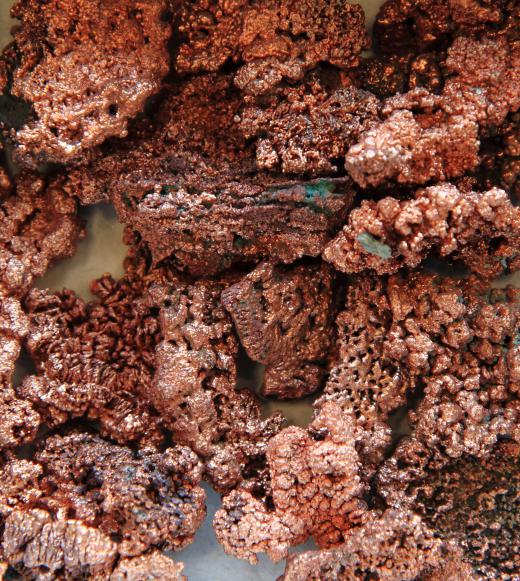What is Nickel?
 Mary McMahon
Mary McMahon
Nickel is a metallic chemical element, classified among the transition metals on the periodic table of elements. Humans have been using this metal in alloys for thousands of years, as traces of it in ancient statues and weapons indicate, although they may not have been aware of the precise properties of the element. There are a number of commercial applications for nickel, making it a very valuable and useful metal; several corporations specialize in mining and processing the ore, along with other metallic elements.
Pure nickel is silvery gray in appearance, and it can be polished to a bright shine. The metal is also ferromagnetic, and very ductile, meaning that it can easily be melted and worked. It is relatively hard and strong, making it a great addition to alloys with softer or more fragile metals. On the periodic table of elements, it is identified with the symbol Ni, and it has an atomic number of 28.

The word comes from the German kupfernickel, which literally means “the devil's copper.” This is a reference to the fact that the ore can resemble copper ore, leading some people to compare the ore to the devil's work or trickery. This ore was used in glazes for pottery before its properties were fully understood, since it created a distinctive greenish blue color. The element was first isolated in 1751 by Alex Fredrik Cronstedt, who was actually trying to get copper, but ended up with nickel instead.

Since nickel resists corrosion and it is relatively strong, many people use it in alloys; stainless steel, for example, often contains this metal. It is also used to plate other metals to ensure that they are protected from corrosion. The metal has also traditionally been used to replace silver in coins; the American nickel coin, for example, once contained a great deal of the metal, although this is no longer the case. It is sometimes mixed in glass when a distinctive green color is desired.
Although nickel is not generally toxic, the element does carry some cautions. Many people experience contact dermatitis when they are exposed to this metal, making it a poor choice for jewelry alloys. Fumes and dust from it can also be very harmful, causing lung infections and irritations. People who work with the metal, especially nickel sulfide, should always wear proper face and mouth protection to stay healthy. Gases which contain nickel are also extremely toxic, and they should be avoided.
AS FEATURED ON:
AS FEATURED ON:












Discussion Comments
I am very allergic to nickel, which can make buying jewelry complicated. It is mostly used in earrings and if your ears get red and itchy when you have earrings in, it is probably a nickel allergy. Also beware of eyeglass frames! Usually, more expensive jewelry is nickel-free and a lot of manufacturers are aware of the allergy problem and print nickel-free labels on their products. The mall jewelry store chain, Claire's, is very good about labeling their products nickel-free.
Post your comments